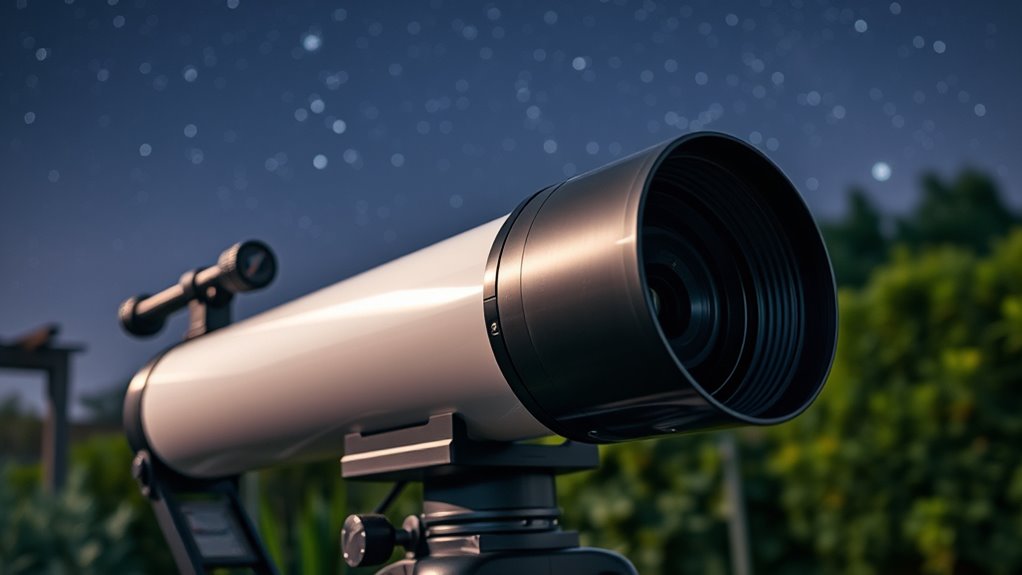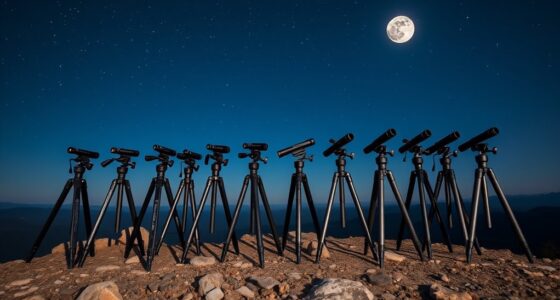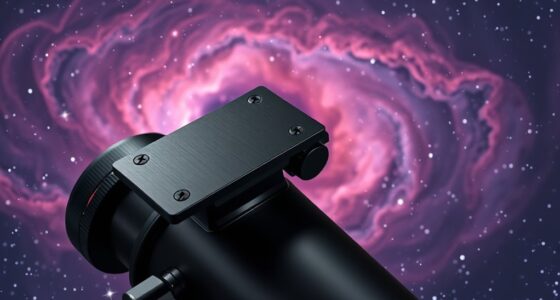If you’re looking for the best apochromatic refractors for your backyard setup, I recommend options like SVBONY SV550, Sky-Watcher EvoStar 100, and Explore Scientific ED102, which combine great optics with portability and ease of use. These scopes offer minimal chromatic aberration, bright images, and compatibility with various mounts, making planetary, lunar, and deep-sky observing a breeze. Keep exploring further to discover more top models tailored to your needs and budget.
Key Takeaways
- Look for models with fully multi-coated optics and specialized glass (e.g., FPL-51, fluorite) for bright, sharp, and color-corrected images.
- Choose lightweight, portable designs with easy setup features suitable for backyard, travel, or field use.
- Ensure compatibility with stable mounts and accessories like star finders, focal reducers, and smartphone adapters for enhanced usability.
- Consider optical performance for lunar, planetary, and deep-sky observation, emphasizing minimal chromatic aberration and high contrast.
- Balance budget and features, selecting options that offer high-quality optics, robust build, and ease of use for both beginners and advanced astronomers.
SVBONY SV550 APO Telescope for Adults
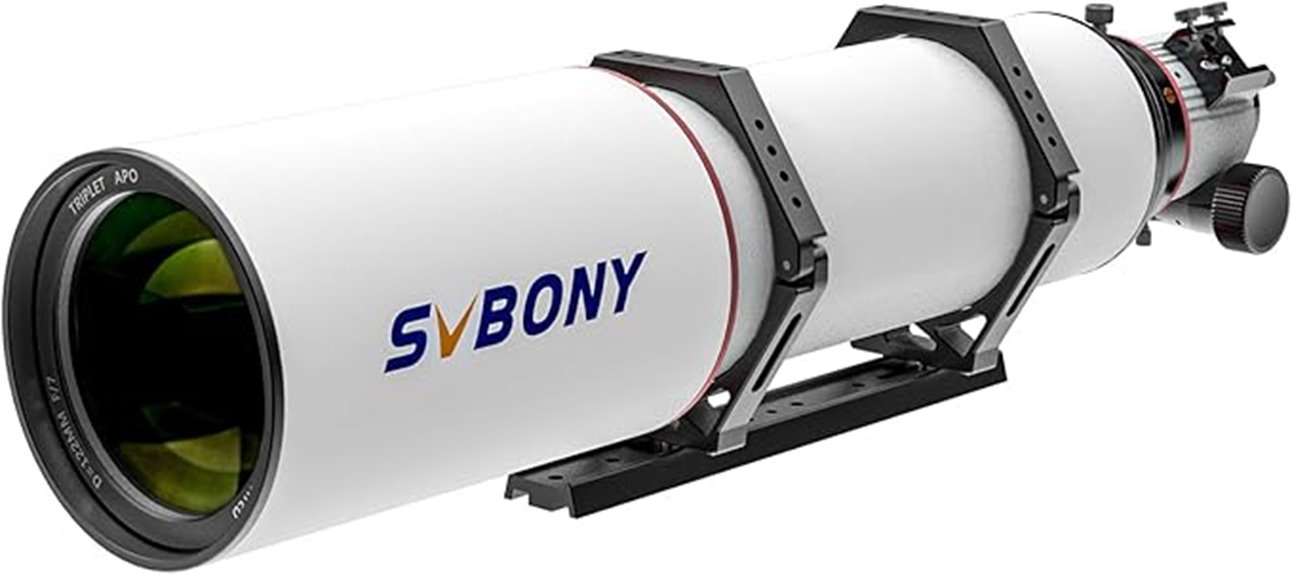
The SVBONY SV550 APO Telescope is an excellent choice for amateur astronomers and astrophotographers who want high-quality images without breaking the bank. Its 122mm aperture gathers plenty of light, delivering sharp, detailed views of planets and deep-sky objects. The FPL-51 triplet apochromatic lens reduces chromatic aberration, ensuring clear images with vibrant colors. At just over 14 pounds, it’s lightweight and portable, making setup and travel easy. The dual-speed focuser offers precise adjustments, while compatibility with various mounts allows versatile use. Overall, it provides excellent optical performance and value, ideal for those seeking professional results in a compact, affordable package.
Best For: amateur astronomers and astrophotographers seeking a high-quality, portable, and affordable APO refractor for detailed planetary and deep-sky observations.
Pros:
- Excellent optical quality with high contrast and sharp images, thanks to the FPL-51 triplet apochromatic lens.
- Lightweight and compact design, making it ideal for travel and easy setup.
- Dual-speed 2.5-inch focuser provides precise focusing adjustments for astrophotography and detailed observation.
Cons:
- Some users have reported dust between lens elements, which may affect image clarity if not cleaned.
- Support and parts replacement can be limited or challenging for some customers.
- Packaging issues or missing parts have occasionally been noted, requiring careful inspection upon receipt.
SVBONY SV503 Refractor Telescope, 102mm F7
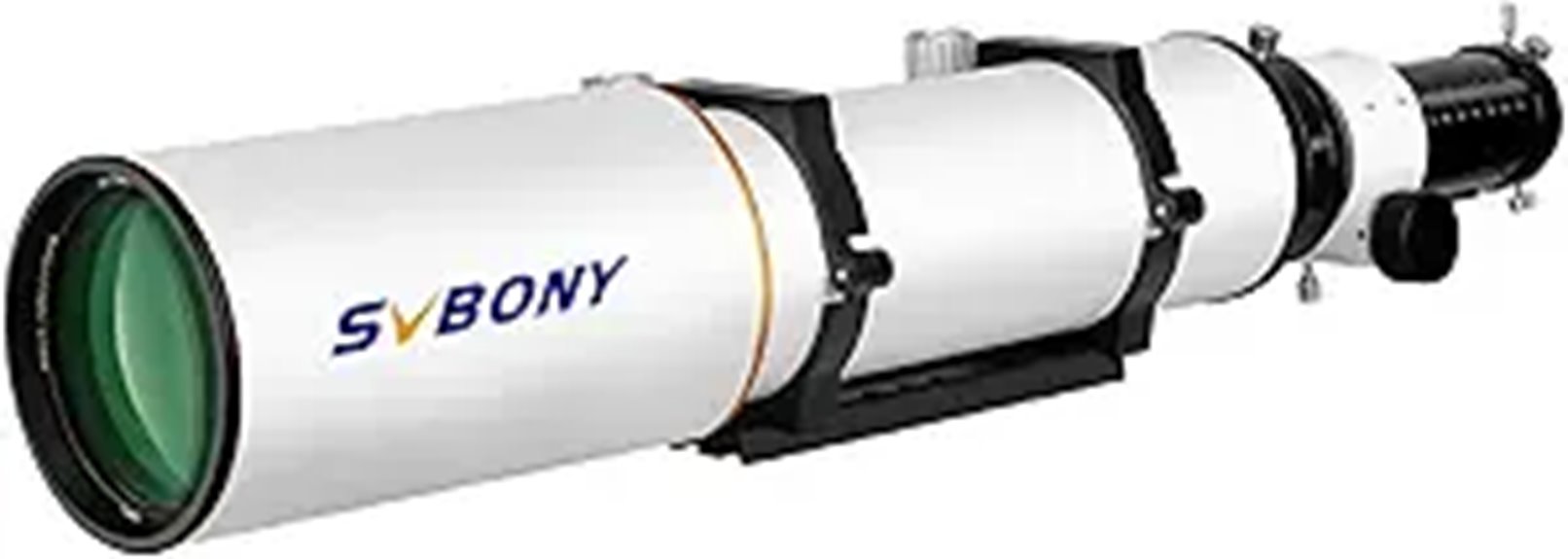
If you’re looking for a high-quality refractor suitable for astrophotography and detailed planetary observation, the SVBONY SV503 Refractor Telescope is an excellent choice. Its 102mm objective lens with F7 focal ratio delivers bright, sharp images with minimal chromatic aberration thanks to the doublet S-FPL51 ED glass. The scope features a dual-speed focuser for precise adjustments and a retractable dew shield to prevent dew buildup. While not a true APO, it offers excellent image quality at an affordable price, making it ideal for both planetary detail and deep-sky imaging. Its solid build and versatile design appeal to hobbyists seeking a reliable, portable astrophotography instrument.
Best For: amateur astronomers and astrophotographers seeking a portable, high-quality refractor for planetary and deep-sky imaging at an affordable price.
Pros:
- Excellent image clarity with minimal chromatic aberration due to S-FPL51 ED glass doublet design
- Smooth dual-speed focuser allows precise focusing adjustments for detailed imaging
- Solid construction with lightweight design making it portable and easy to handle
Cons:
- Slight initial focuser backlash that may require minor adjustment
- Not a true apochromatic scope, so some minor chromatic aberration may be visible on very bright objects
- No included storage case, requiring separate purchase for transport and storage
Sky-Watcher EvoStar 100 APO Refractor Optical Tube

Apochromatic refractors like the Sky-Watcher EvoStar 100 APO are ideal for astronomers who demand crisp, color-corrected images whether observing visually or capturing astrophotography. Its expertly matched glass, including a synthetic fluorite element, minimizes false color and aberrations, producing sharp, accurate images. The 100mm aperture offers bright, detailed views of planets, deep-sky objects, and the Moon. The lightweight design, with a high-quality dual-speed focuser and included accessories, makes setup quick and easy. Its optical coatings and matte interior prevent stray reflections, ensuring high contrast. Overall, it’s a versatile, portable scope perfect for both beginner and advanced astronomers seeking excellent image quality.
Best For: amateur astronomers and astrophotographers seeking a high-quality, portable apochromatic refractor for visual observation and imaging.
Pros:
- Excellent color correction with expertly matched glass, including synthetic fluorite element
- Lightweight and portable design around 8.4 pounds, suitable for less robust mounts
- High-quality dual-speed Crayford-style focuser for precise focusing
Cons:
- Limited aperture size may not satisfy those seeking very deep-sky imaging capabilities
- Slightly higher cost compared to basic refractors, reflecting its premium optical features
- Requires compatible mount for optimal use, which may add to overall setup cost
Telescope for Adults with 90mm Aperture and 900mm Focal Length
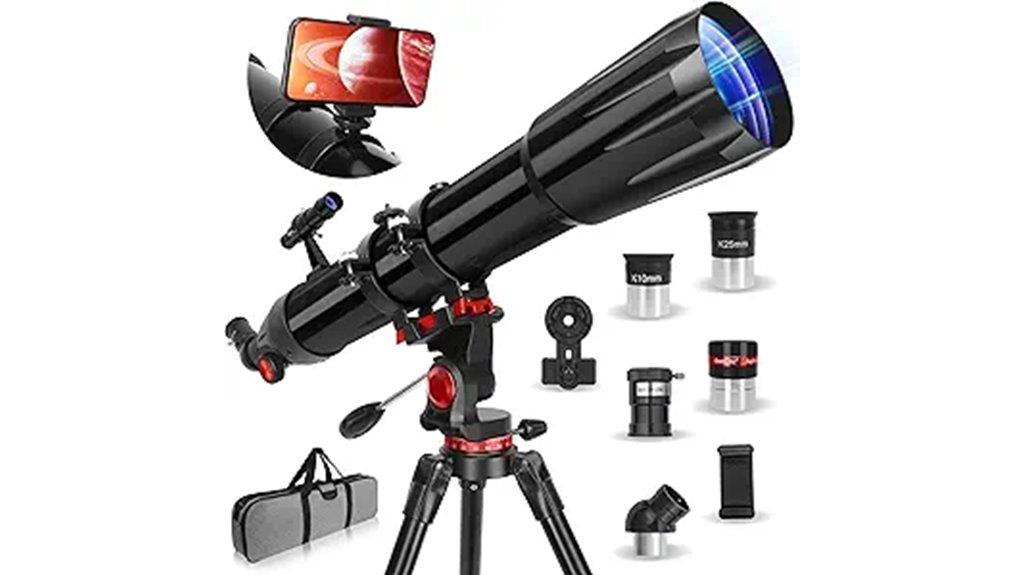
Designed for adult astronomy enthusiasts, this 90mm aperture telescope with a 900mm focal length offers exceptional image clarity thanks to its apochromatic optics. It delivers bright, detailed views of the Moon, planets, and stars, thanks to its fully multi-coated lenses that reduce reflections and enhance sharpness. With magnification options from 36X to 450X, you can explore lunar craters or planetary surfaces in fine detail. The sturdy tripod ensures stability, while its compact, lightweight design makes it easy to set up and transport. Perfect for beginners and seasoned hobbyists alike, this telescope balances performance, ease of use, and affordability for stellar backyard observing.
Best For: amateur astronomy enthusiasts, beginners, and families seeking an easy-to-use, portable telescope for detailed lunar, planetary, and star viewing.
Pros:
- High-quality 90mm aperture with fully multi-coated lenses for bright, sharp images
- Versatile magnification range up to 450X suitable for detailed planetary and lunar observations
- Portable design with sturdy tripod and accessories, making setup and transport convenient
Cons:
- May require some initial adjustment and familiarization for optimal use
- Limited to daytime terrestrial viewing without additional accessories
- Slightly higher price point compared to basic entry-level telescopes
Telescope for Adults, 90mm Refractor with Mount, Tripod & Accessories
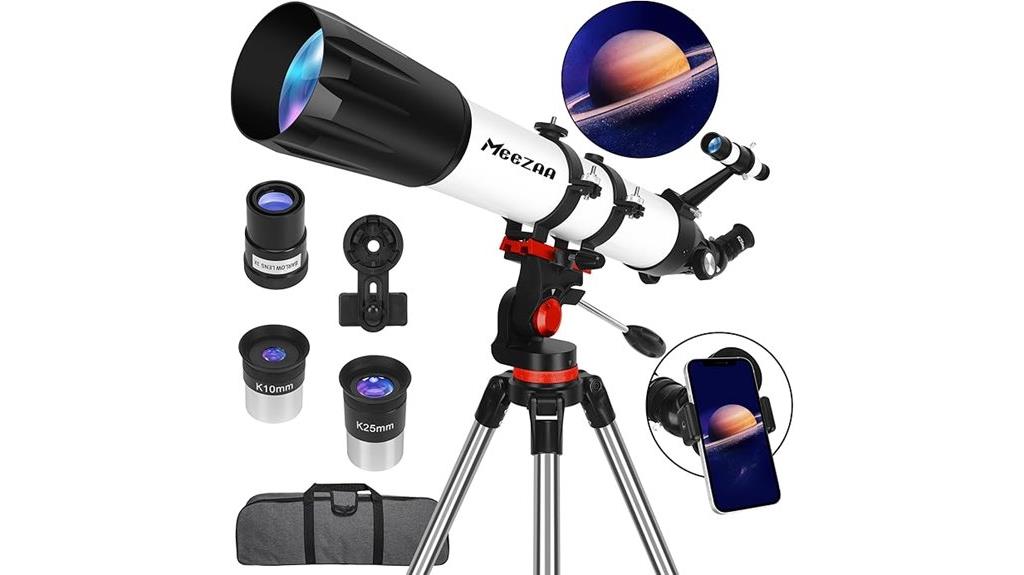
This 90mm refractor telescope is an excellent choice for adults and beginners who want clear, sharp images of the moon, planets, and brighter deep-sky objects. Its 90mm aperture and 800mm focal length deliver bright, detailed views, enhanced by fully multi-coated lenses. The package includes a sturdy adjustable tripod, a phone adapter for capturing images, and a convenient carry bag. Setup is quick and straightforward, making it perfect for backyard stargazing, outdoor trips, or star parties. Compact and lightweight, it’s easy to transport and assemble, offering great value and reliable performance for those starting their astronomy journey or seeking an affordable, user-friendly instrument.
Best For: beginners and adults interested in exploring astronomy, stargazing, and nature observation with an easy-to-use, portable telescope.
Pros:
- Bright, clear images of the moon, planets, and brighter deep-sky objects thanks to 90mm aperture and multi-coated lenses
- Quick and simple setup with a sturdy, adjustable tripod, ideal for backyard, outdoor trips, and star parties
- Comes with useful accessories including a phone adapter and carry bag for easy transportation and photo capturing
Cons:
- The small finder scope may be confusing for beginners due to inverted image orientation
- Manual tracking can be challenging for absolute beginners without additional stabilization or motorized mounts
- Slight wobbling during fine focus adjustments and the potential for minor alignment issues with the phone adapter
Celestron Advanced VX 6 Refractor Telescope
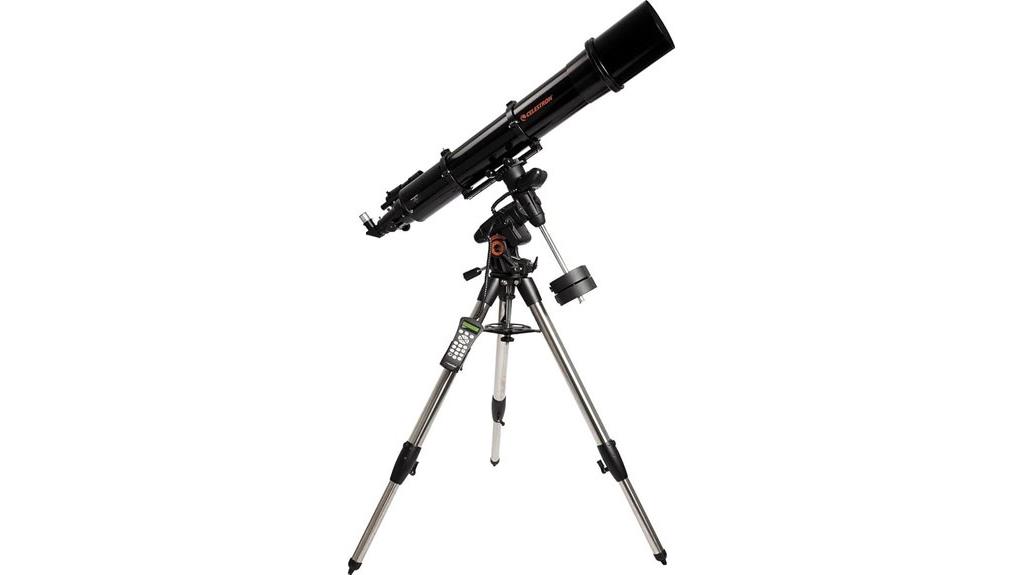
Are you seeking a high-quality refractor telescope capable of delivering sharp planetary and lunar images? The Celestron Advanced VX 6 Refractor offers superb optics with fully coated lenses for bright, clear views. Its unobstructed aperture and f/8 focal ratio provide high contrast, ideal for planetary observation. While chromatic aberration is present, it’s manageable with filters. The telescope’s 5-foot-6-inch tube can be cumbersome to transport, and the focuser might need upgrades for stability. The Advanced VX mount is computerized with GoTo capabilities, tracking thousands of objects, but the overall size and weight make setup and portability challenging. It’s a solid choice for dedicated backyard astronomers.
Best For: dedicated backyard astronomers seeking high-quality planetary and lunar views with a versatile refractor telescope.
Pros:
- Superior optics with fully coated lenses for bright, clear images
- High contrast due to unobstructed aperture and f/8 focal ratio, ideal for planetary observation
- Technologically advanced features like GoTo tracking and All-Star Polar Alignment for precise targeting
Cons:
- Large, cumbersome 5 ft 6 in tube makes transportation and setup challenging
- Focuser may need upgrades for added stability when using heavy equipment
- Size and weight limit portability, especially in small vehicles or for field use
Telescope, 90mm Aperture 900mm Astronomical Refractor Telescope
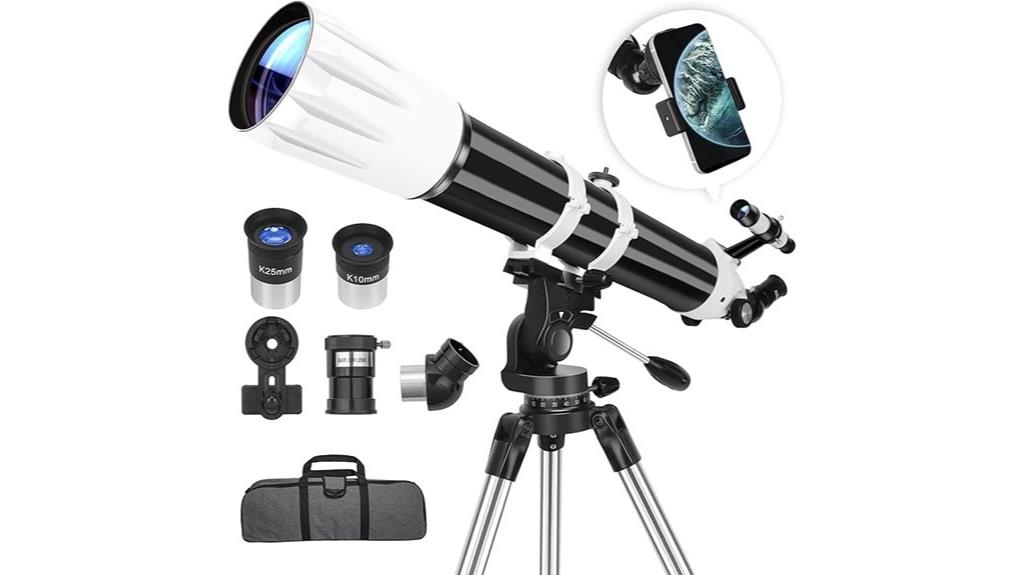
If you’re looking for a telescope that delivers sharp, high-contrast images with minimal chromatic aberration, the 90mm aperture 900mm refractor is an excellent choice—especially for beginners and amateur astronomers. With a large 90mm lens and Fully Multi-Coated optics, it produces bright, clear views of the Moon, planets, and deep-sky objects. Its stable stainless steel tripod offers smooth, adjustable support, making setup quick and easy. The included accessories, like eyepieces, Barlow lens, and smartphone adapter, enhance your observing experience. Lightweight and portable, this telescope is perfect for backyard viewing, outdoor trips, or capturing images, offering great value for aspiring stargazers.
Best For: beginners, amateur astronomers, and outdoor enthusiasts seeking a portable, easy-to-use telescope with high-quality optics for celestial and terrestrial viewing.
Pros:
- Bright, sharp, high-contrast images with minimal chromatic aberration thanks to Fully Multi-Coated optics and large 90mm aperture
- Easy to assemble within about 15 minutes with no extra tools required, making it accessible for beginners
- Portable and lightweight with a stable stainless steel tripod, perfect for outdoor trips and backyard observation
Cons:
- Limited to a maximum magnification of 270X, which may restrict viewing of very distant or detailed celestial objects
- Requires manual adjustment for tracking objects, not motorized or computerized for automatic locating
- Slightly bulky accessories and setup may be challenging for very compact storage or quick grab-and-go situations
Telescopes for Adults Astronomy (80mm Aperture 600mm)
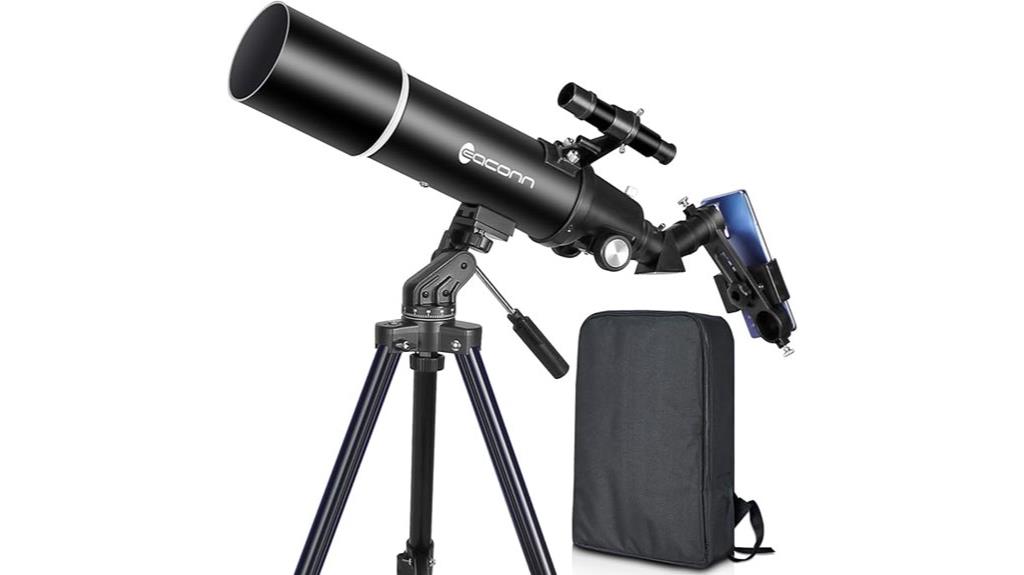
Apochromatic refractors excel for amateur astronomers seeking high-precision, color-corrected observations, especially when viewing planets, the moon, and deep-sky objects. The 80mm aperture and 600mm focal length of this telescope deliver bright, crisp images, ideal for detailed lunar craters, Saturn’s rings, and star clusters. Its lightweight design, weighing just 6.8 pounds, makes it portable and perfect for outdoor adventures. The included sturdy tripod, easy assembly, and versatile accessories like two eyepieces and a mobile phone adapter enhance user experience. Whether for casual stargazing or educational fun, this telescope offers excellent value and impressive performance for adult hobbyists.
Best For: beginner and casual adult astronomy enthusiasts interested in portable, easy-to-use telescopes for moon, planet, and deep-sky observation.
Pros:
- Compact and lightweight design (6.8 pounds) for easy transport and outdoor use
- Bright, clear images with high-quality coated optics and versatile eyepieces
- User-friendly setup with detailed instructions, making it suitable for beginners and kids
Cons:
- May have minor calibration issues with the finder scope for precise object locating
- Limited aperture size may not satisfy advanced astronomers seeking deeper-sky viewing
- Some users report occasional focus difficulties or build quality concerns
Sky-Watcher Evolux 82ED Doublet Apo Refractor Telescope

The Sky-Watcher Evolux 82ED Doublet Apo Refractor Telescope stands out as a practical choice for amateur astronomers seeking high-quality, portable optics without breaking the bank. Its lightweight, compact design makes it ideal for wide-field astrophotography and quick setups. The ED doublet lens and metallic high-transmission coatings deliver sharp, contrast-rich images with minimal false color. While some users report minor chromatic aberration and build quality concerns, overall, the Evolux offers good optical performance for visual use and astrophotography at around $629. It’s a versatile, budget-friendly option for those wanting quality optics in a portable package.
Best For: amateur astronomers and astrophotographers seeking a portable, budget-friendly refractor with good optical performance for wide-field imaging and casual observing.
Pros:
- Lightweight and compact design ideal for travel and quick setups
- Sharp, contrast-rich images with minimal false color thanks to ED doublet lenses and high-transmission coatings
- Affordable price point offering good value for entry- to mid-level users
Cons:
- Build quality and mechanical components may feel cheap or lightweight, with some users experiencing focus stiffness or durability issues
- Occasional manufacturing variability leading to issues like stuck focus rings or chromatic aberration
- May require additional accessories such as field flattener or reducer for optimal imaging with larger sensors
Gskyer 600x90mm AZ Refractor Telescope for Astronomy
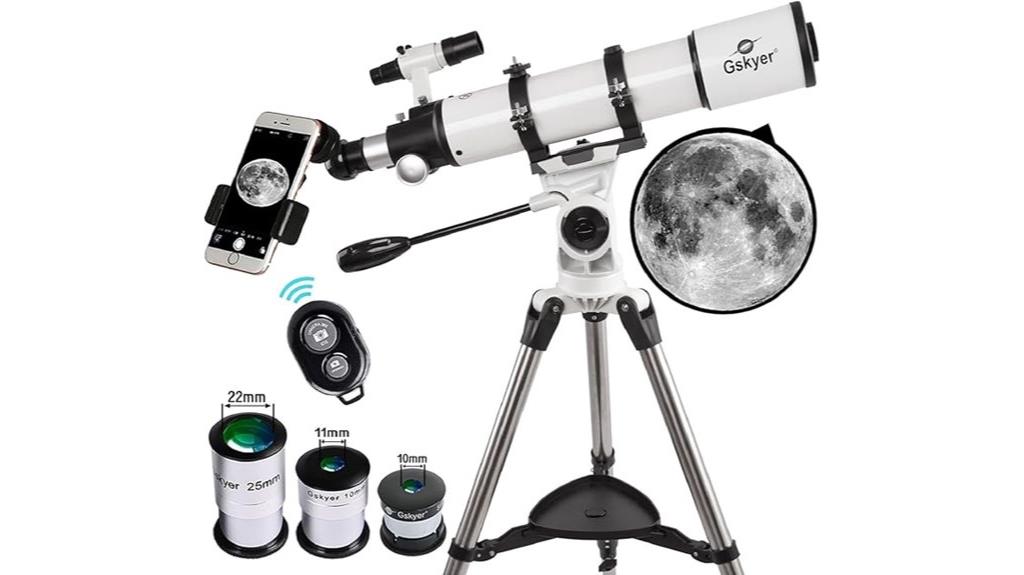
Designed for beginners and amateur astronomers, the Gskyer 600x90mm AZ Refractor Telescope offers easy setup and straightforward operation, making it an ideal choice for those just starting to explore the night sky. Its 600mm focal length and 90mm aperture produce sharp, clear images, enhanced by fully coated optics that protect your eyes. With three interchangeable eyepieces and a 3x Barlow lens, you can easily adjust magnification from 24X to 120X. The adjustable aluminum tripod provides flexible viewing angles and heights. No tools are needed for assembly, and it includes friendly customer support, making astronomy accessible and enjoyable.
Best For: beginners and amateur astronomers seeking an easy-to-use telescope for exploring the night sky.
Pros:
- Easy setup with no tools required, ideal for beginners.
- Versatile magnification options with three eyepieces and a 3x Barlow lens.
- Adjustable aluminum tripod allows for comfortable viewing at various heights.
Cons:
- Limited to beginner and casual stargazing, not suitable for advanced astronomy.
- Magnification range may be insufficient for detailed planetary observation.
- The lightweight tripod might be less stable during prolonged or high-magnification viewing.
Explore Scientific ED80 Refractor Telescope for Astrophotography

If you’re serious about astrophotography and want sharp, high-contrast images, the Explore Scientific ED80 Refractor Telescope is an excellent choice. Its high-quality FCD1 HOYA ED glass and multi-layer coatings deliver superb detail with minimal chromatic aberration, making it ideal for capturing everything from lunar craters to nebulae. Its compact, portable design with a 480mm focal length makes spontaneous astrophotography sessions easy. While some mounting adjustments may be needed, its versatile focal ratio and excellent optics ensure crisp images. Overall, the ED80 combines portability, performance, and reliability, making it a top option for dedicated amateur astrophotographers.
Best For: amateur astronomers and astrophotographers seeking a portable, high-contrast refractor for capturing lunar, planetary, and deep-sky images with excellent optical quality.
Pros:
- High-contrast, sharp images with minimal chromatic aberration thanks to genuine FCD1 HOYA ED glass and multi-layer coatings
- Compact and lightweight design (approximately 5.95 pounds) for easy portability and spontaneous observing sessions
- Versatile f/6 focal ratio suitable for astrophotography of various celestial objects, with good back focus for extension tubes
Cons:
- Mounting system relies on a single screw which may require modifications for stability
- Proprietary finder scope mount may need additional rings or adapters for proper attachment
- Some users report minor manufacturing defects and mounting stability issues that may need adjustments
GALAEYES 100mm Aperture Telescope with Star Finding System
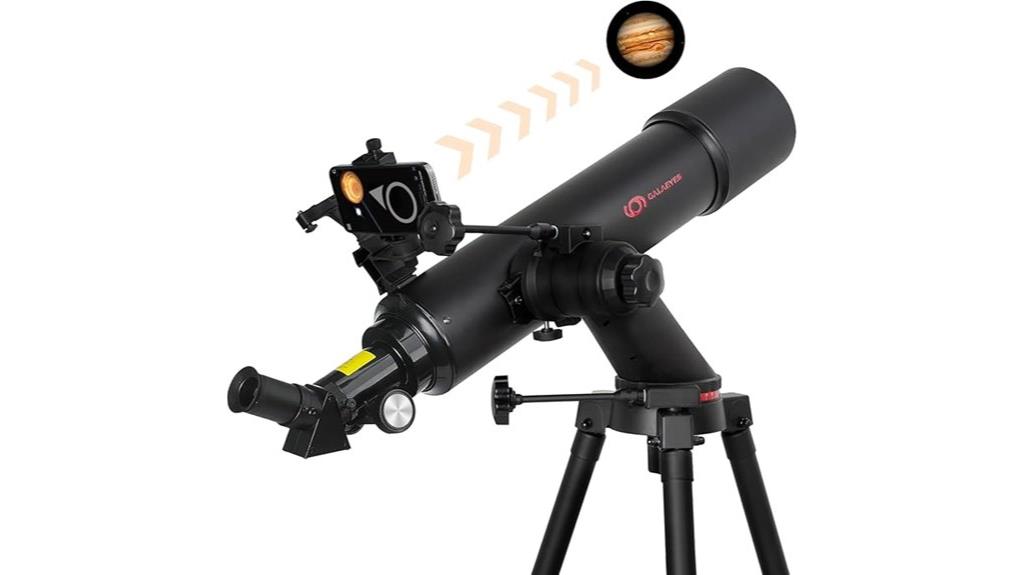
Apochromatic refractors like the GALAEYES 100mm Aperture Telescope with Star Finding System are perfect for amateur astronomers and serious enthusiasts who demand high image clarity. Its 100mm aperture gathers ample light, producing brighter, sharper images of planets and deep-sky objects. The two low-dispersion ED glass elements eliminate chromatic aberration, ensuring true color fidelity. The fully multi-coated lens maximizes light transmission, delivering crisp details. With a 600mm focal length and F/6 ratio, it’s versatile for planetary detail and nebulae. The built-in star-finding system simplifies alignment, making celestial navigation easier. It’s a user-friendly, portable choice for both visual and astrophotography pursuits.
Best For: amateur astronomers and serious enthusiasts seeking high-quality, portable telescopic observation and astrophotography capabilities.
Pros:
- High light-gathering capability with a 100mm aperture for brighter, sharper images.
- Advanced star-finding system for quick and accurate celestial navigation.
- Supports both visual observation and astrophotography, compatible with smartphones and cameras.
Cons:
- Additional mounts and adapters are sold separately, which may increase overall cost.
- The telescope’s height adjustment and setup may require some familiarity for optimal use.
- Limited to specific accessories and mounts, potentially restricting expandability for advanced imaging setups.
Celestron AstroMaster 102AZ Telescope

The Celestron AstroMaster 102AZ telescope is an excellent choice for beginners and casual astronomers seeking a straightforward, budget-friendly refractor. Its 102mm fully coated achromatic lens offers bright, sharp images of the Moon, planets, and star clusters. The lightweight, portable design and sturdy adjustable tripod make setup quick and easy, perfect for quick observing sessions. With simple alt-azimuth tracking, you can effortlessly follow objects across the sky. While tripod stability can be an issue, many users find its optical clarity and ease of use make it a reliable, value-packed tool for exploring the night sky without breaking the bank.
Best For: beginner and casual astronomers, kids, and anyone seeking an easy-to-use, budget-friendly telescope for lunar and planetary observation.
Pros:
- Bright, sharp images of the Moon, planets, and star clusters due to 102mm fully coated lens
- Lightweight, portable, and quick to set up, ideal for beginners and casual use
- Simple alt-azimuth mount with smooth movement and included accessories like finderscope and software
Cons:
- Tripod stability issues can cause vibrations and difficulty in precise tracking
- Limited for deep-sky astrophotography or detailed celestial observation
- Slightly heavier for some users to carry and position during extended sessions
Dianfan Telescope, 90mm Aperture 800mm Refractor Telescope for Adults
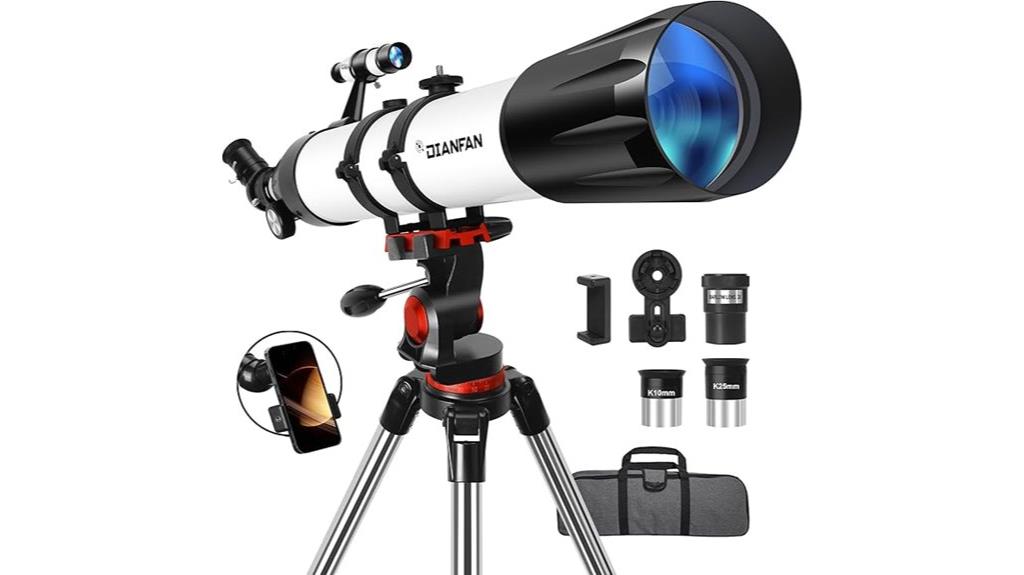
For anyone new to astronomy or looking for a portable, high-quality telescope, the Dianfan Telescope with its 90mm aperture and 800mm focal length is an excellent choice. Its fully coated objective lens gathers plenty of light, providing bright, sharp images of the moon, planets, and terrestrial scenes. With two eyepieces and a 3× Barlow lens, you can enjoy magnifications from 32× to 240×, perfect for detailed lunar and planetary views. The easy-to-assemble design, lightweight tripod, and intuitive mount make setup quick and straightforward. Plus, the smartphone adapter allows for simple astrophotography, making this scope versatile for beginners and enthusiasts alike.
Best For: beginners, amateur astronomers, and outdoor enthusiasts seeking an easy-to-use, portable, high-quality telescope for lunar, planetary, and terrestrial viewing.
Pros:
- Bright, clear images with high contrast due to fully coated optics and large 90mm aperture
- Quick and simple assembly with lightweight tripod and user-friendly mount, ideal for beginners
- Versatile magnification options from 32× to 240×, plus smartphone adapter for astrophotography
Cons:
- Limited to daytime terrestrial viewing without additional accessories
- May require careful handling to avoid misalignment during setup for optimal image quality
- Slightly smaller aperture compared to larger telescopes, which may limit deep-sky observation potential
Explore Scientific ED102 Telescope for Astrophotography

Looking for a high-quality telescope that makes astrophotography accessible even in light-polluted areas? The Explore Scientific ED102 Essential Series Air-Spaced Apochromatic Refractor delivers sharp, high-contrast images thanks to genuine FCD1 HOYA ED glass and multi-layer coatings. Its 102mm aperture, f/7 focal ratio, and triplet design eliminate chromatic aberration, perfect for capturing detailed shots of the Moon, planets, nebulae, and star clusters. Lightweight and portable, it pairs well with mounts like Celestron AVX or ZWO AM3, making setup quick and straightforward. Despite not being the latest model, it offers excellent value for astrophotographers seeking quality results from less-than-ideal observing conditions.
Best For: amateur astronomers and astrophotographers seeking a portable, high-quality refractor capable of capturing detailed images in light-polluted environments.
Pros:
- High-contrast, sharp images with minimal chromatic aberration due to genuine FCD1 HOYA ED glass and multi-layer coatings
- Lightweight and portable design facilitates quick setup and travel flexibility
- Excellent value for its price point, especially for astrophotography from light-polluted skies
Cons:
- Slight star shape distortions may occur due to mounting screw adjustments
- Initial focuser backlash requires tension adjustments; may need eventual upgrade
- Some minor imperfections in collimation or glass can cause small airy disc irregularities
Factors to Consider When Choosing Apochromatic Refractor for Backyard

When selecting an apochromatic refractor for my backyard, I focus on optical quality and aperture to guarantee clear, sharp images. I also consider portability and mount stability, since convenience and steady tracking are key for enjoyable viewing. Finally, I evaluate my budget to find the best balance of features and value for my specific needs.
Optical Quality and Aperture
The optical quality of an apochromatic refractor plays a crucial role in delivering sharp, high-contrast images with minimal chromatic aberration across the entire field of view. High-quality lenses often use extra-low dispersion (ED) glass and multi-layer coatings, which considerably reduce color fringing and enhance clarity. Aperture size, typically between 80mm and 102mm or larger, directly impacts light-gathering ability and detail resolution. Larger apertures provide brighter, more detailed images but come with increased weight and cost, requiring sturdier mounts. The combination of excellent optical quality and appropriate aperture allows for crisp, vibrant views of celestial objects and improved astrophotography results. Balancing these factors ensures you get the best possible performance suited to your backyard setup.
Portability and Size
Ever wondered how portability influences your choice of apochromatic refractor for backyard astronomy? If so, you’ll find that smaller, lightweight models—usually under 100mm—are much easier to transport and set up. These compact scopes are perfect if you need quick assembly or limited storage space. Larger refractors, with 100mm or more aperture, tend to be heavier, often over 10 pounds, making frequent moving more cumbersome. Innovative features like foldable or collapsible designs and retractable dew shields help reduce overall size, boosting portability. Additionally, choosing lightweight tripods or portable mounts makes setup simpler and more stable during observation sessions. Overall, considering size and weight guarantees your telescope fits comfortably into your outdoor space and your busy schedule.
Mount Compatibility and Stability
Choosing an apochromatic refractor that matches your mount’s specifications is essential for stable, clear viewing. Make sure the scope’s aperture size aligns with your mount’s weight capacity and compatibility to avoid strain and vibrations. Check that the mounting foot or dovetail plate fits your system, whether V-style or Losmandy rails. Be mindful of the refractor’s weight and accessories to prevent overloading lightweight mounts, which can cause tracking issues. Opt for a scope with a sturdy mounting interface and a balanced center of gravity to reduce stress and enhance stability during observation. Additionally, select a mount with adjustable tension controls and damping mechanisms that can handle the refractor’s weight and length. This ensures steady, vibration-free viewing, improving your overall experience.
Imaging Capabilities and Accessories
Selecting an apochromatic refractor that supports your astrophotography goals means paying attention to its imaging capabilities and accessories. High-quality models deliver sharper, more accurate images by minimizing chromatic aberration. Many come with useful accessories like field flatteners, focal reducers, and extension tubes, which help optimize image quality across various targets. Compatibility with cameras such as DSLRs or dedicated astro cameras is essential; most scopes support T-ring adapters and guide scopes for precise tracking. Achieving perfect focus and correct back focus distance is vital, so look for adjustable focusers and calibrated extension tubes. Additionally, filters like moon, nebula, and UV/IR cut filters can greatly enhance image contrast, reduce glare, and improve color fidelity, ensuring your astrophotos are clear and vibrant.
Budget and Value
Wondering how to get the best value when choosing an apochromatic refractor for your backyard setup? The key is balancing cost with features. High-quality models usually run between $1,000 and $3,000, but you can find excellent options under $1,000 that still offer great optical performance. When evaluating value, compare their optical qualities, build, included accessories, and warranty against the price. Investing a bit more often results in better color correction, sharper images, and increased durability, which can save you money long-term. Budget-conscious enthusiasts should consider used or refurbished scopes that have been inspected professionally to maximize value without sacrificing performance. Ultimately, choosing an scope that fits your budget while delivering essential features ensures you get the best bang for your buck.
Frequently Asked Questions
What Is the Typical Cost Range for High-Quality Apochromatic Refractors?
High-quality apochromatic refractors typically cost between $1,000 and $4,000, depending on size, brand, and features. I’ve found that as you move higher in price, you usually get better glass, improved coatings, and more precise construction, which enhances image quality. If you’re serious about astronomy and want sharp, color-free images, investing within this range is worth it. For casual stargazing, there are also more affordable options, but they may not deliver the same clarity.
How Does Chromatic Aberration Affect Image Quality in Astrophotography?
Chromatic aberration blurs and colors the edges of stars and planets, reducing image sharpness and detail. I’ve noticed it makes my astrophotos look less crisp and vibrant, especially around bright objects. To avoid this, I use apochromatic refractors, which correct for these color fringing. When I choose quality optics, my images become clearer, more accurate, and truly stunning, making the extra investment totally worth it.
Are Apochromatic Refractors Suitable for Beginners or Only Advanced Astronomers?
Apochromatic refractors are great for beginners because they offer sharp, clear images with minimal chromatic aberration, making your learning curve smoother. I found them user-friendly and rewarding, even if they’re often more expensive. They’re a fantastic choice if you want quality optics without needing advanced skills. So, yes, they’re suitable for beginners who want to enjoy high-quality views and start their astronomy journey confidently.
What Maintenance Is Required to Keep an Apochromatic Refractor in Optimal Condition?
Back in the day, telescopes needed constant TLC, and apochromatic refractors are no different. To keep yours in peak shape, I recommend regularly cleaning the lenses with proper tools, keeping the tube dust-free, and storing it in a dry, stable environment. Also, check the focuser and mount for smooth operation and tighten any loose screws. A little routine maintenance goes a long way in preserving ideal performance.
Can These Telescopes Be Used Effectively for Solar or Planetary Observation?
Absolutely, apochromatic refractors are excellent for solar and planetary observation. Their high contrast and sharp images let me see fine details on the Sun, planets, and moon. I just make sure to use proper solar filters for safe solar viewing, and I keep the optics clean for the clearest images. Their precision and clarity make them my go-to choice for detailed planetary and solar observations.
Conclusion
Choosing the right apochromatic refractor can truly elevate your backyard astronomy experience. Did you know that a well-chosen telescope can reveal up to 20% more detail in celestial objects? Whether you’re into planetary views or deep-sky imaging, there’s an option for you. Remember, investing in quality optics not only enhances your stargazing but also makes the journey more enjoyable. Happy observing—your perfect telescope awaits!
